The swallows are grouping up on the phone lines. The monarchs are on the move. There’s the first hint of color in the maple leaves. Orion greets you in the early morning darkness. Winter is on its way. Time to get bird feeders cleaned and filled!
Feeding birds in winter is a fun family activity. It’s a great way to learn how to identify the birds. Since many summer residents have migrated, there’s a smaller number of species to match with those in your field guides. And the birds are up close. You don’t have to crane your neck for that flick of feathers disappearing behind a branch full of leaves.
For starters, I rely on just two kinds of bird food: black oil sunflower seed and what I call “bird food goop.” I mix vegetable shortening with the cheapest mixed bird seed I can find.
An easy feeder for the goop is a small-sized log about a 2 or 3 inches in diameter and 1 foot long. Drill 1 inch diameter holes about 1 inch into the log in a variety of places. Attach a cord or a hook to hang it. Fill the holes with the bird food goop. Simple. Even easier: take a cardboard egg carton, remove the top, then attach a string to it. Fill the cups with the goop. You’ll get chickadees and woodpeckers hanging on it and getting much needed fat for energy.
Of course you can spend a lot of money buying bird feeders to fill with the sunflower seed, but there’s much more fun in designing your own. Plus if you’re repurposing plastic and cardboard containers, there’s an added benefit in the care for our environment.
I’ve designed an inexpensive bird feeder out of three 32-ounce Gatorade plastic bottles.
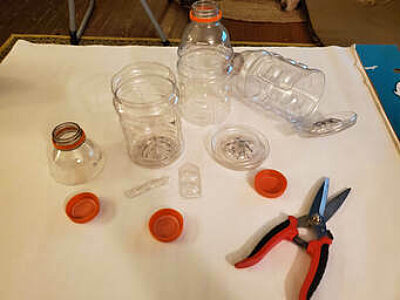
First make a container for the seeds. Take two of the bottles and cut off the bottoms. Take one bottle and cut slits 2 1/2 inches up from the cut-off bottom parallel to its ridges. This allows you to crimp the open end of that bottle so that it can fit and slide into the open end of the other. Snap the two bottles together.
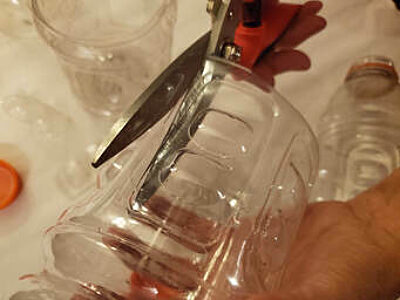
Now make a place where the birds can get the seeds. Take the third bottle and cut the top off, just above the narrow indentation that goes around the bottle (about 2 inches down from the bottle opening.) This will form the portion of the feeder that the seeds will spill into.
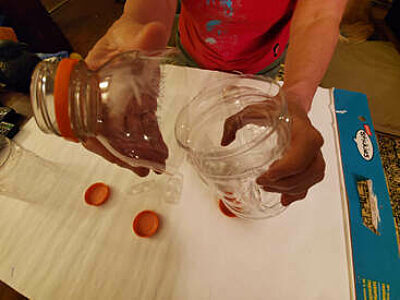
Cut out two opposite or three alternating holes, like windows, around the bottle near the bottom. That’s where birds will have access to the seed. Cut two slits about 1 1/2 inches long down from the top where it was cut off.
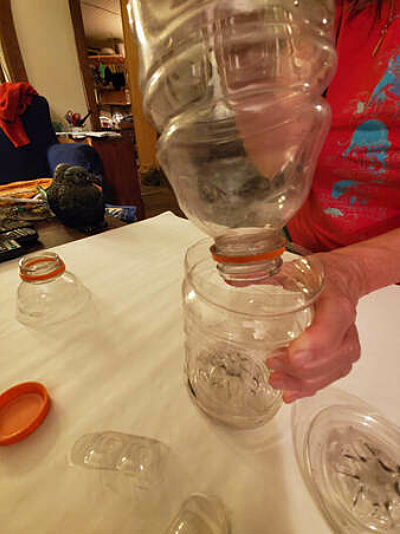
To finish, snap the seed container portion into the opening of the third bottle. Attach a string or wire to the top of the feeder. If a squirrel chews it up, no problem -- build another one!
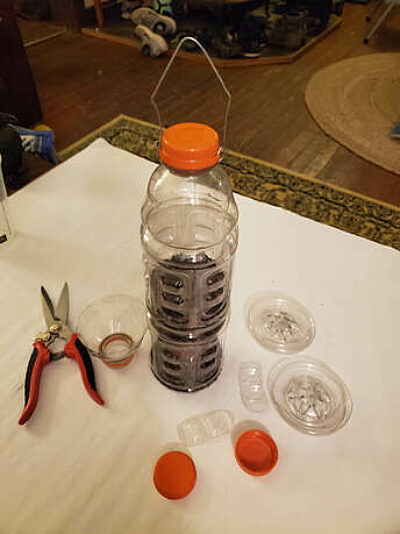
Finally, as far as feeder ideas, there’s the human bird feeder. Yes, a human. This works great at a picnic table, though you could set it up on a lawn chair. Build a frame large enough to hang an overcoat with a brimmed hat to top it off. Place this in the middle of your feeding area. Sprinkle seed on with the hat and coat. You could even glob the bird food goop onto shoulders or in pockets. The birds will get used to this “scarecrow” laden with food and use it. If you have someone that would like to have an up close experience with the birds, simply place the coat and hat on that person. Have them sit in the chair or at the table. Sprinkle seed on the hat and about the coat. Remind them to stay still - they are the feeder!
Be sure to put feeders up where there is shelter for the birds to perch and avoid predators. Christmas trees at the end of the holiday season are fine. Don’t forget water. Winter is a hard time for birds to find it, so providing a heated birdbath will provide an additional incentive.
I’m never sure who enjoys these backyard feeders more, you or the birds!
